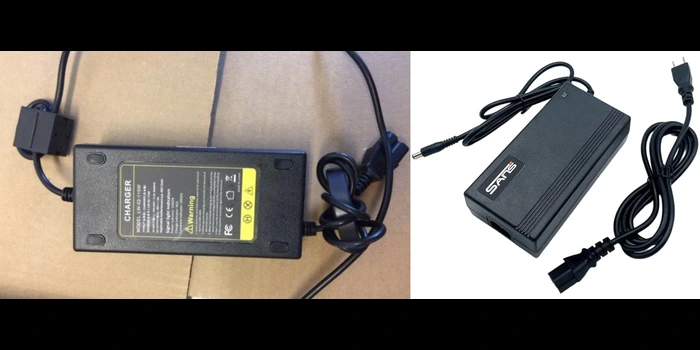Your electric bike’s charger is the unsung hero that keeps the fun rolling. Think of it as the fuel pump for your cycling adventures. While all e-bike chargers serve the same basic purpose, understanding the nuances of 48V chargers, in particular, will ensure you make the best choice and fully maximize your e-bike’s potential. This guide breaks down everything you need to know about them!

Contents
- 1 Understanding 48V Electric Bike Chargers
- 2 Types of 48V Electric Bike Chargers
- 3 Choosing the Right 48V Charger for Your E-Bike
- 4 Pros of 48V Electric Bike Chargers
- 5 Cons of 48V Electric Bike Chargers
- 6 Why a Quality 48V Charger Matters in the USA
- 6.1 FAQs
- 6.2 1. Can I use my 48V charger with different capacity (Ah) batteries?
- 6.3 2. Is using a fast charger bad for my battery?
- 6.4 3. Should I always fully discharge my battery before charging?
- 6.5 4. Can I leave my e-bike charger plugged in all the time?
- 6.6 5. My charger gets very hot, is this normal?
- 6.7 Conclusion
Understanding 48V Electric Bike Chargers
- Voltage Specific: 48V chargers are designed for e-bikes with 48-volt battery systems. Incorrect voltage can damage your battery and potentially other components.
- Power Delivery: Chargers are rated in amperes (amps). Higher amps offer faster charging speeds but need to be compatible with your battery.
- Plug Types: Connectors will vary (XLR, barrel connectors, etc.). Double-check compatibility with your bike’s charging port.
- Smart Chargers: Many have multi-stage charging cycles and automatic cut-off, extending battery life and preventing overcharging.
Types of 48V Electric Bike Chargers
- Standard Chargers: The most basic and often bundled with new e-bikes. Typically 2-4 amps, offering a reliable, if somewhat slower, charging process.
- Fast Chargers: Boast higher amperage (e.g., 5+ amps) to significantly reduce charging times. Great for topping up quickly on the go or long-range rides.
- Portable Chargers: Smaller, lighter chargers designed for convenience when away from home outlets. Useful for extended excursions.
- Brand-Specific Chargers: E-bike manufacturers often have their own proprietary chargers. These offer tailored charging protocols but may be more expensive.
Choosing the Right 48V Charger for Your E-Bike
- Battery Compatibility: The voltage and connector type must align perfectly with your e-bike’s 48V battery system.
- Charging Speed Needs: How quickly do you need a full charge? Fast chargers are pricier but provide convenience.
- Portability: Want a charger for home use only or something for travel?
- Features: Smart charging, built-in fans, LED charge indicators. These elevate performance and safety.
- Brand Reputation: Trusted brands are worth the investment for quality and peace of mind.
Pros of 48V Electric Bike Chargers
- Essential for E-bike Ownership: Simply put, you can’t ride without a functional charger!
- Extended Range: A proper charger keeps your battery powered up, expanding the distances you can explore.
- Time-Saving: Fast chargers shorten the time between riding, ideal for frequent cyclists.
- Improved Battery Health: Smart features optimize charging, prolonging battery lifespan.
Cons of 48V Electric Bike Chargers
- Cost: Compared to chargers for simpler electronics, higher-quality e-bike chargers can be an investment.
- Compatibility: You need a charger specifically matching your 48V battery setup.
- Deliberate Usage: Improper charging or a poorly-made charger can shorten battery lifespan.
Full Suspension E-Bikes and 48V Chargers
While these off-road e-bikes often have 48V systems, there’s no impact on charger choice beyond ensuring compatibility as outlined above.
Why a Quality 48V Charger Matters in the USA
- Ride-Focused Lifestyle: US cyclists increasingly rely on e-bikes for commuting, errands, and long-range recreation demanding a reliable charger.
- Varied Terrains: Covering vast distances or hilly areas makes having an efficient charger essential to the experience.
- Investment Protection: Good chargers contribute to a healthy battery, maintaining your e-bike’s long-term value.
FAQs
1. Can I use my 48V charger with different capacity (Ah) batteries?
Yes, as long as they’re all 48V batteries. The mAh (milliamp-hour) or Ah (amp-hour) rating influences the battery range, not the charging process. A larger-capacity battery will simply take longer to charge.
2. Is using a fast charger bad for my battery?
Not inherently, if your battery is designed for faster charging rates. It’s safest to consult your battery manual. Some “smart” fast chargers adjust depending on the battery.
3. Should I always fully discharge my battery before charging?
No, that’s a myth from older-style batteries. Lithium-ion batteries used in e-bikes perform best with partial ‘top-offs’. Avoid deep discharges unless recommended by the manufacturer.
4. Can I leave my e-bike charger plugged in all the time?
Ideally not. “Smart” chargers with auto shut-off are safer, but for the absolute longest battery life, unplug after charging is complete.
5. My charger gets very hot, is this normal?
Slight warmth is expected, but excess heat may indicate a poor-quality or malfunctioning charger. Consult the manufacturer or an e-bike repair expert for an assessment.
Conclusion
Your 48V electric bike charger is far more than a simple accessory– it’s the vital bridge between your electric dreams and a fully-powered ride. While some chargers may seem similar superficially, the differences in their capabilities directly impact your overall e-biking experience. In the vast US landscapes, where e-bikes offer a refreshing change of pace for transportation or thrilling rides through nature, having a reliable, well-suited charger is non-negotiable.
By grasping the essentials, weighing your personal needs, and perhaps investing in a fast charger or additional portable charger, you’ll reap the maximum rewards of owning an electric bike. Your charger won’t just keep your battery healthy – it fuels the freedom, the adventure, and the endless joy that each e-bike ride promises.
